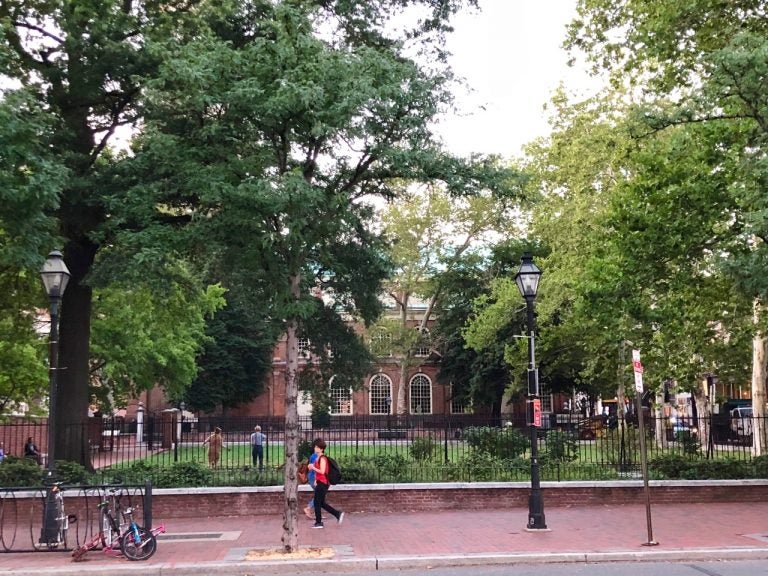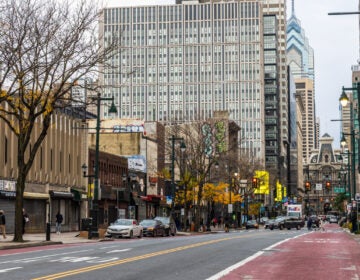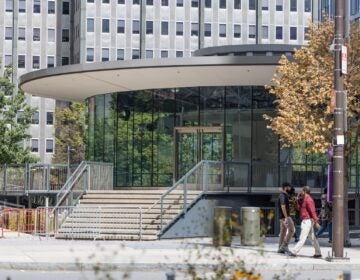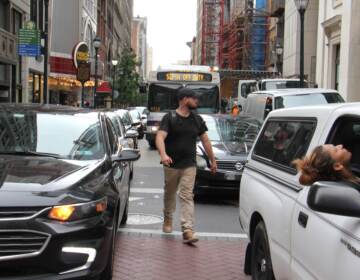Brainstorming how to make an Old City park as welcoming as its surroundings
The corner of Second and Market streets in Old City is laden with history.

James Wilson Park at Second and Market streets, alongside Christ Church, is underused despite its potential — and its location. (Meir Rinde/PlanPhilly)
This story originally appeared on PlanPhilly.
—
The corner of Second and Market streets in Old City is laden with history. As Philadelphia’s original civic center, the neighboring block was the site of the city’s first town hall and courthouse, as well as the bustling 18th-century headhouse that gave Market Street its name. The Academy of Natural Sciences first met here in 1812. Just to the north, historic Christ Church continues to draw hundreds of thousands of visitors a year.
Less well-known than the church is the adjacent park at the intersection’s northeastern corner. Often called Christ Church Park but actually named James Wilson Park, it’s a scrubby open lawn, overhung with large trees and surrounded by iron fencing, with gated entrances toward the back of the site. From the corner of Second and Market, a brick wall blocks the view into the park.
Despite the neighborhood’s vibrancy, the park at its center is underused and feels unwelcoming, nearby residents say.
“It’s a little closed off, and it’s mostly used for dog-walking. It should be a little more open and accessible,” said Ben Kunkel, who lives steps away on Church Street. “The seating could probably be better, a little bit more inviting. There are basically four seats pointing into the park, so if you go into the park you’re kind of on display.”
Katrina Johnston-Zimmerman, an urban anthropologist who has studied the park, said she’s seen people approach the entrances and then back away, apparently unsure whether they would feel comfortable in the park’s confines.
“It is a low-performing space. Especially as compared to other really well-loved and -used neighborhood parks, there’s not a lot of activity,” she said at a meeting Wednesday night sponsored by Old City District. “Not a lot of variety, not a lot of staying activity in particular, and not a lot of sense of ownership or comfort in the space that really makes people feel like it’s their public space.”
Old City District, the area’s business improvement district, has targeted the park for a makeover as part of its Vision 2026 plan. The two-year-old initiative aims to enrich life in the district for residents and visitors, in part by improving its public spaces and walkability. The process of studying and reimagining the park is funded by a $40,000 state grant and has the support of the site’s owner, the National Park Service. The project review committee includes Christ Church, the city’s Planning Commission, and several local businesses and property owners.
Wednesday’s meeting at Christ Church Neighborhood House is set to be followed up by an open design workshop at the Christ Church Farmer’s Market on Aug. 8. Jonas Maciunas, a planner who is leading the design process and who co-wrote the Vision 2026 framework, said the group will use the public feedback and the results of an online survey to pull together by September perhaps a dozen ideas for redesigning the park. A proposal concept should be ready by the end of the year, he said.
While Old City District and the designers say the final proposal will be shaped by community input, the Vision 2026 framework published in 2016 recommends several changes. Those include new entrances “that conform with pedestrians’ expectations and convenience;” seating such as park benches, seat walls, or movable tables and chairs; placemaking elements such as water features, monuments and public art; new trees and plantings; and walking paths, which the report described as “essential to green spaces.”
Any changes would need the approval and participation of the National Park Service — Wilson Park is part of Independence National Historical Park, along with Independence Hall, Washington Square Park, and a number of other sites.
“It’s an interesting space because it’s federally owned; it’s owned by the Park Service for a very specific purpose. We’re grateful the Park Service is letting us take a look,” Old City District’s executive director, Job Itzkowitz, said.
An Independence National Historical Park spokeswoman declined to comment Thursday on whether the park leadership would be open to substantial changes like removing walls or adding new entrances at Wilson Park. During a presentation Wednesday night, Doris Fanelli, chief of Independence NHP’s division of cultural resources management, said Wilson Park and open spaces next to two other churches in the national park were created in the 1960s as quiet areas rather than loci of activity.
“The parks actually provide solitude and respite from the city outside these walls and fences. They’re actually forecourts from the churches that they’re framing. You leave the secular world, stay in the quiet area, and then move to the sacred world where the churches are, metaphorically of course,” she said.
Fanelli said the open spaces were established to protect the three churches from fire and to create views to frame the historic structures. Independence National Historical Park’s properties use a common vocabulary of historically aware materials and designs developed by the National Park Service. That treatment “links them to the parks landscape and also links them to one another, so that visitors walking around will see the same landscape vocabulary, will see the same designs and understand the relationships,” she said.
At the same time, Wilson Park “could be planted more beautifully, with some help, and maintained better,” she said. “We welcome suggestions that will work within our guidelines and constraints, and we want to set this exercise up for success.”
Johnston-Zimmerman said a number of elements may contribute to underuse of the park. Other than four inward-facing stone benches along the back wall, there are essentially no seating options other than the grass. A brick barrier around the lawn is too low to sit on comfortably. The park lacks secluded corners, turning it into a kind of open stage. There is no signage except a warning against unleashed dogs. People don’t know the park’s name and may think it’s part of Christ Church.
From various outside perspectives, the park is obscured by trees, a SEPTA subway headhouse, a brick wall, and multiple rows of fencing. A large raised planter distances it from Market Street.
As a result, Wilson Park sees little informal activity except by people walking their dogs, who briefly socialize with one another or with people sitting on the benches before leaving, Johnston-Zimmerman said. People sometimes lie or sleep on the benches, and the brick walkway along the back is used as a pass-through.
Yet the park has “very high potential,” she said. “It is a small space but quite expansive. It has a lot of opportunity for people to set up a picnic blanket or a hammock or have their kid run around, bring a dog or not bring a dog, and so on. There is a lot of opportunity for more cross-traffic; there are a lot of people on the streets around the space who can be brought in if they knew how to get there from the street.”
Itzkowitz said changes to the park could dovetail with a larger set of proposed modifications to the intersection of Market and Second streets that would improve pedestrian and bicycle access. The Vision 2026 report envisions a plaza-like space for the street with a separated bike lane, a wide median, and a narrow lane for cars. Old City District has a design plan that it hopes the city’s Streets Department will adopt to reshape the intersection, he said.
“We want to make Old City as pedestrian-friendly as possible,” Itzkowitz said. “We want more people here, we want to support growth, but also preserve the historic character.”
WHYY is your source for fact-based, in-depth journalism and information. As a nonprofit organization, we rely on financial support from readers like you. Please give today.







